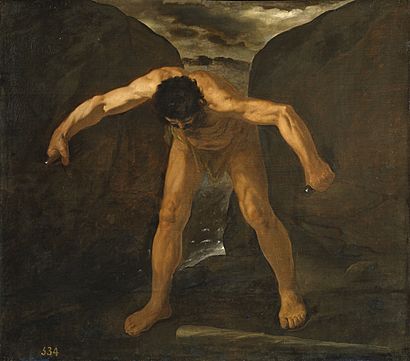Hercules Separates Mounts Calpe and Abylla facts for kids
Quick facts for kids Hercules Separates Mounts Calpe and Abylla |
|
|---|---|
| Spanish: Hércules separa los montes Calpe y Abyla | |
 |
|
| Artist | Francisco de Zurbarán |
| Year | 1634 |
| Medium | oil on canvas |
| Dimensions | 136 cm × 167 cm (54 in × 66 in) |
| Location | Museo del Prado, Madrid |
Hercules Separates Mounts Calpe and Abylla is a famous painting by Francisco de Zurbarán. He created this artwork in 1634. It shows the ancient Greek hero Hercules performing one of his legendary feats. The painting is part of a series made for a royal palace in Spain.
Contents
What the Painting Shows
This painting is quite large, measuring 136 centimeters tall and 167 centimeters wide. It is kept in the Museo del Prado in Madrid, Spain. The artwork depicts the strong hero Hercules using his immense power to push apart two mountains. These mountains are known as Mount Calpe and Mount Abylla.
Who is Hercules?
Hercules is a very famous hero from ancient Greek and Roman myths. He was known for his incredible strength and bravery. Many stories tell of his amazing adventures and the twelve difficult tasks, or "labors," he had to complete. He was a son of the god Zeus.
The Pillars of Hercules
The two mountains in the painting, Mount Calpe and Mount Abylla, are very important. Today, Mount Calpe is known as the Rock of Gibraltar. Mount Abylla is thought to be either Monte Hacho in Ceuta or Jebel Musa in Morocco. These two mountains stand on opposite sides of the Strait of Gibraltar. This narrow strait connects the Atlantic Ocean to the Mediterranean Sea. In ancient times, these mountains were called the "Pillars of Hercules." They were believed to mark the end of the known world.
Hercules' Legendary Feat
According to one myth, Hercules created the Strait of Gibraltar. He either pushed the two mountains apart or made them closer together. This allowed the Atlantic Ocean to flow into the Mediterranean Sea. The painting shows him in the act of separating them. This act symbolized his great strength and his role in shaping the world.
About the Artist: Francisco de Zurbarán
The artist, Francisco de Zurbarán, was a very important Spanish painter. He lived from 1598 to 1664. He is famous for his religious paintings and his skill in showing textures and shadows. Zurbarán was a key artist during the Spanish Golden Age. This was a time when art and culture in Spain were at their peak.
Why This Painting Was Made
Hercules Separates Mounts Calpe and Abylla was part of a larger project. It was one of ten paintings that Zurbarán created for the Hall of Realms. This hall was in the Buen Retiro Palace in Madrid. King Philip IV of Spain ordered these paintings. They were meant to celebrate the power and glory of the Spanish monarchy. The stories of Hercules were used to show the king's own strength and wisdom.
See also
 In Spanish: Hércules separa los montes Calpe y Abyla para niños
In Spanish: Hércules separa los montes Calpe y Abyla para niños

